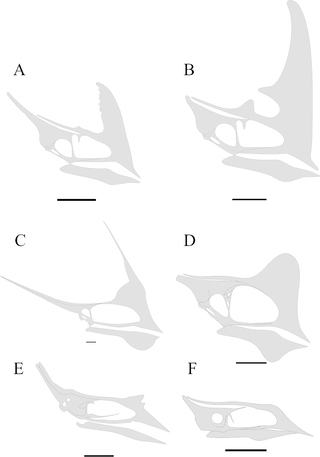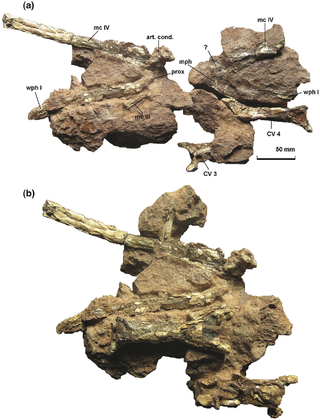
Pterosaurs are an extinct clade of flying reptiles in the order Pterosauria. They existed during most of the Mesozoic: from the Late Triassic to the end of the Cretaceous. Pterosaurs are the earliest vertebrates known to have evolved powered flight. Their wings were formed by a membrane of skin, muscle, and other tissues stretching from the ankles to a dramatically lengthened fourth finger.

Quetzalcoatlus is a genus of azhdarchid pterosaur known from the Late Cretaceous Maastrichtian age of North America. Its name comes from the Aztec feathered serpent god Quetzalcoatl. The type species is Q. northropi, named by Douglas Lawson in 1975. The genus also includes the smaller species Q. lawsoni, which was known for many years as an unnamed species, before being named by Brian Andres and Wann Langston Jr. (posthumously) in 2021. Q. northropi has gained fame as a candidate for the largest flying animal ever discovered.

Anurognathus is a genus of small pterosaur that lived during the Late Jurassic period. Anurognathus was first named and described by Ludwig Döderlein in 1923. The type species is Anurognathus ammoni. The specific name ammoni honours the Bavarian geologist Ludwig von Ammon, from whose collection Döderlein had acquired the fossil in 1922.

Azhdarchidae is a family of pterosaurs known primarily from the Late Cretaceous Period, though an isolated vertebra apparently from an azhdarchid is known from the Early Cretaceous as well. Azhdarchids are mainly known for including some of the largest flying animals discovered, but smaller cat-size members have also been found. Originally considered a sub-family of Pteranodontidae, Nesov (1984) named the Azhdarchinae to include the pterosaurs Azhdarcho, Quetzalcoatlus, and Titanopteryx. They were among the last known surviving members of the pterosaurs, and were a rather successful group with a worldwide distribution. Previously it was thought that by the end of the Cretaceous, most pterosaur families except for the Azhdarchidae disappeared from the fossil record, but recent studies indicate a wealth of pterosaurian fauna, including pteranodontids, nyctosaurids, tapejarids and several indeterminate forms. In several analyses, some taxa such as Navajodactylus, Bakonydraco and Montanazhdarcho were moved from Azhdarchidae to other clades.

Azhdarcho is a genus of azhdarchid pterosaur from the late Cretaceous Period of the Bissekty Formation of Uzbekistan, as well as the Zhirkindek Formation of Kazakhstan and possibly also the Ialovachsk Formation of Tajikistan. It is known from fragmentary remains including the distinctive, elongated neck vertebrae that characterizes members of the family Azhdarchidae, a family that includes many giant pterosaurs such as Quetzalcoatlus. The name Azhdarcho comes from the Persian word azhdar (اژدر), a dragon-like creature in Persian mythology. The type species is Azhdarcho lancicollis. The specific epithet lancicollis is derived from the Latin words lancea and collum ("neck").

Thalassodromeus is a genus of pterosaur that lived in what is now Brazil during the Early Cretaceous period, about a hundred million years ago. The original skull, discovered in 1983 in the Araripe Basin of northeastern Brazil, was collected in several pieces. In 2002, the skull was made the holotype specimen of Thalassodromeus sethi by palaeontologists Alexander Kellner and Diogenes de Almeida Campos. The generic name means "sea runner", and the specific name refers to the Egyptian god Seth due to its crest being supposedly reminiscent of Seth's crown. Other scholars have pointed out that the crest was instead similar to the crown of Amon. A jaw tip was assigned to T. sethi in 2005, became the basis of the new genus Banguela in 2014, and assigned back to Thalassodromeus as the species T. oberlii in 2018. Another species was described in 2015 based on a supposed crest fragment, but this was later shown to be part of a turtle shell.

Tapejaridae are a family of pterodactyloid pterosaurs from the Cretaceous period. Members are currently known from Brazil, England, Hungary, Morocco, Spain, the United States, and China. The most primitive genera were found in China, indicating that the family has an Asian origin.

Hatzegopteryx is a genus of azhdarchid pterosaur found in the late Maastrichtian deposits of the Densuş Ciula Formation, an outcropping in Transylvania, Romania. It is known only from the type species, Hatzegopteryx thambema, named by Buffetaut et al. in 2002 based on parts of the skull and humerus. Additional specimens, including a neck vertebra, were later placed in the genus, representing a range of sizes. The largest of these remains indicate it was among the biggest pterosaurs, with an estimated wingspan of 10 to 12 metres.

Noripterus is a genus of dsungaripterid pterodactyloid pterosaur from Lower Cretaceous-age Lianmuqin Formation in the Junggar Basin of Xinjiang, China. It was first named by Yang Zhongjian in 1973. Additional fossil remains have been recovered from Tsagaantsav Svita, Mongolia.

Chaoyangopterus is a genus of chaoyangopterid pterosaur known from a partial skeleton found in Liaoning, China. Chaoyangopterus was found in rocks dating back to the Aptian-age Lower Cretaceous Jiufotang Formation of Dapingfang, Chaoyang.

Istiodactylus is a genus of pterosaur that lived during the Early Cretaceous period, about 120 million years ago. The first fossil was discovered on the English Isle of Wight in 1887, and in 1901 became the holotype specimen of a new species, O. latidens, in the genus Ornithodesmus. This species was moved to its own genus, Istiodactylus, in 2001; this name is Greek for "sail finger". More specimens were described in 1913, and Istiodactylus was the only pterosaur known from three-dimensionally preserved fossils for much of the 20th century. In 2006, a species from China, I. sinensis, was assigned to Istiodactylus, but it has also been suggested to belong to a different genus.
Eoazhdarcho is a genus of azhdarchoid pterodactyloid pterosaur named in 2005 by Chinese paleontologists Lü Junchang and Ji Qiang. The type and only known species is Eoazhdarcho liaoxiensis. The fossil was found in the Aptian-age Lower Cretaceous Jiufotang Formation of Chaoyang, Liaoning, China.

Phosphatodraco is a genus of azhdarchid pterosaur that lived during the Late Cretaceous of what is now Morocco. In 2000, a pterosaur specimen consisting of five cervical (neck) vertebrae was discovered in the Ouled Abdoun Phosphatic Basin. The specimen was made the holotype of the new genus and species Phosphatodraco mauritanicus in 2003; the genus name means "dragon from the phosphates", and the specific name refers to the region of Mauretania. Phosphatodraco was the first Late Cretaceous pterosaur known from North Africa, and the second pterosaur genus described from Morocco. It is one of the only known azhdarchids preserving a relatively complete neck, and was one of the last known pterosaurs. Additional cervical vertebrae have since been assigned to the genus, and it has been suggested that fossils of the pterosaur Tethydraco represent wing elements of Phosphatodraco.

Haopterus is a genus of pterodactyloid pterosaur from the Barremian-Aptian-age Lower Cretaceous Yixian Formation of Liaoning, China. Its fossil remains dated back 124.6 million years ago.

Huanhepterus is an extinct genus of ctenochasmatid pterodactyloid pterosaur from the Early Cretaceous period of what is now Qingyang, Gansu, China.

Nurhachius is a genus of istiodactylid pterodactyloid pterosaur from the Barremian to Aptian-age Lower Cretaceous Jiufotang Formation of Chaoyang, Liaoning, China. Its fossil remains date back about 120 million years ago.
Longchengpterus, sometimes misspelled as "Lonchengopterus", is a genus of istiodactylid pterodactyloid pterosaur from the Barremian-Aptian-age Lower Cretaceous Jiufotang Formation of Chaoyang, Liaoning, China. Its fossil remains dated back about 120 million years ago.

Tupandactylus is a genus of tapejarid pterodactyloid pterosaur from the Early Cretaceous Crato Formation of Brazil.
Elanodactylus is a genus of ctenochasmatid pterodactyloid pterosaur from the Early Cretaceous period of what is now the Yixian Formation of Liaoning, China.

Eurazhdarcho is a genus of azhdarchid pterosaur from the Late Cretaceous period of what is now the Transylvanian Basin of Romania. Its fossil remains dated back 69 million years ago.

































